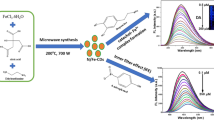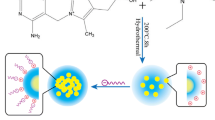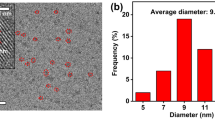Abstract
Carbon dots codoped with magnesium and nitrogen (Mg,N-CDs) were synthesized via a one-step microwave-assisted method. They display blue fluorescence (with excitation/emission peaks at 380/460 nm and a 33% quantum yield) and possess high dispersity in aqueous solution. The fluorescence of the Mg,N-CDs is highly sensitive to paraoxon in the presence of pralidoxime (PAM) acting as the linking agent. Electron transfer from Mg,N-CDs to paraoxon in the presence of PAM leads to the fluorescence quenching of Mg,N-CDs. The concentration of paraoxon is determined by measuring the quenching efficiency of the Mg,N-CD-PAM assay system. Fluorescence drops with increasing concentrations of paraoxon in the 0.005–3.0 μM range, and the limit of detection is 0.87 nM. The method is highly selective for paraoxon even in the presence of possible interferences. Real sample study of tap and river water showed the assay to have good repeatability and accuracy.

Schematic diagram of magnesium and nitrogen co-doped carbon dots (Mg,N-CDs) as a fluorescent probe for paraoxon detection by using pralidoxime as a linker.








Similar content being viewed by others
References
Jariyal M, Jindal V, Mandal K, Gupta VK, Singh B (2018) Bioremediation of organophosphorus pesticide phorate in soil by microbial consortia. Ecotox Environ Safe 159:310–316
Fahimi-Kashani N, Hormozi-Nezhad MR (2016) Gold-nanoparticle-based colorimetric sensor Array for discrimination of organophosphate pesticides. Anal Chem 88(16):8099–8106
Yan X, Li H, Wang X, Su X (2015) A novel fluorescence probing strategy for the determination of parathion-methyl. Talanta 131:88–94
Saraji M, Jafari MT, Mossaddegh M (2016) Carbon nanotubes@silicon dioxide nanohybrids coating for solid-phase microextraction of organophosphorus pesticides followed by gas chromatography-corona discharge ion mobility spectrometric detection. J Chromatogr A 1429:30–39
Tunesi MM, Kalwar N, Abbas MW, Karakus S, Soomro RA, Kilislioglu A, Abro MI, Hallam KR (2018) Functionalised CuO nanostructures for the detection of organophosphorus pesticides: a non-enzymatic inhibition approach coupled with nano-scale electrode engineering to improve electrode sensitivity. Sensor Actuat B-Chem 260:480–489
Chen H, Zhang H, Yuan R, Chen S (2017) Novel double-potential Electrochemiluminescence Ratiometric strategy in enzyme-based inhibition biosensing for sensitive detection of organophosphorus pesticides. Anal Chem 89(5):2823–2829
Rebollar-Perez G, Lima-Zambrano F, Bairan G, Rodriguez-Enriquez A, Ornelas-Soto N, Mendez E, Torres E (2016) Colorimetric assay for detection of organophosphorus pesticides by decrease of standard catalytic activity of Chloroperoxidase. Environ Eng Sci 33(12):951–961
Zhao F, Tian Y, Wang H, Liu J, Han X, Yang Z (2016) Development of a biotinylated broad-specificity single-chain variable fragment antibody and a sensitive immunoassay for detection of organophosphorus pesticides. Anal Bioanal Chem 408(23):6423–6430
Tan MJ, Hong Z, Chang M, Liu C, Cheng H, Loh XJ, Chen C, Liao C, Kong KV (2017) Metal carbonyl-gold nanoparticle conjugates for highly sensitive SERS detection of organophosphorus pesticides. Biosens Bioelectron 96:167–172
Yan X, Song Y, Zhu C, Li H, Du D, Su X, Lin Y (2018) MnO2 Nanosheet-carbon dots sensing platform for sensitive detection of organophosphorus pesticides. Anal Chem 90(4):2618–2624
Wu ZL, Liu ZX, Yuan YH (2017) Carbon dots: materials, synthesis, properties and approaches to long-wavelength and multicolor emission. J Mater Chem B 5(21):3794–3809
Zu F, Yan F, Bai Z, Xu J, Wang Y, Huang Y, Zhou X (2017) The quenching of the fluorescence of carbon dots: a review on mechanisms and applications. Microchim Acta 184(7):1899–1914
Sun X, Lei Y (2017) Fluorescent carbon dots and their sensing applications. Trac-Trend Anal Chem 89:163–180
Sharma V, Tiwari P, Mobin SM (2017) Sustainable carbon-dots: recent advances in green carbon dots for sensing and bioimaging. J Mater Chem B 5(45):8904–8924
Chaudhary S, Umar A, Bhasin KK, Singh S (2017) Applications of carbon dots in nanomedicine. J Biomed Nanotechnol 13(6):591–637
Han M, Zhu S, Lu S, Song Y, Feng T, Tao S, Liu J, Yang B (2018) Recent progress on the photocatalysis of carbon dots: classification, mechanism and applications. Nano Today 19:201–218
Niu W, Zhu R, Yan-Hua ZH, Cosnier S, Zhang X, Shan D (2016) One-pot synthesis of nitrogen-rich carbon dots decorated graphene oxide as metal-free electrocatalyst for oxygen reduction reaction. Carbon 109:402–410
Xu Q, Kuang T, Liu Y, Cai L, Peng X, Sreeprasad TS, Zhao P, Yu Z, Li N (2016) Heteroatom-doped carbon dots: synthesis, characterization, properties, photoluminescence mechanism and biological applications. J Mater Chem B 4(45):7204–7219
Wang Z, Long P, Feng Y, Qin C, Feng W (2017) Surface passivation of carbon dots with ethylene glycol and their high-sensitivity to Fe3+. RSC Adv 7(5):2810–2816
Guo X, Ding Z, Deng S, Wen C, Shen X, Jiang B, Liang H (2018) A novel strategy of transition-metal doping to engineer absorption of carbon dots for near-infrared photothermal/photodynamic therapies. Carbon 134:519–530
Zhang Z, Chen J, Duan Y, Liu W, Li D, Yan Z, Yang K (2018) Highly luminescent nitrogen-doped carbon dots for simultaneous determination of chlortetracycline and sulfasalazine. Luminescence 33(2):318–325
Zhang Z, Yan K, Yang Q, Liu Y, Yan Z, Chen J (2017) One-pot synthesis of fluorescent nitrogen-doped carbon dots with good biocompatibility for cell labeling. Luminescence 32(8):1488–1493
Shan X, Chai L, Ma J, Qian Z, Chen J, Feng H (2014) B-doped carbon quantum dots as a sensitive fluorescence probe for hydrogen peroxide and glucose detection. Analyst 139(10):2322–2325
Liu T, Li N, Dong JX, Luo HQ, Li NB (2016) Fluorescence detection of mercury ions and cysteine based on magnesium and nitrogen co-doped carbon quantum dots and IMPLICATION logic gate operation. Sensor Actuat B-Chem 231:147–153
Wang N, Zheng A, Liu X, Chen J, Yang T, Chen M, Wang J (2018) Deep eutectic solvent-assisted preparation of nitrogen/chloride-doped carbon dots for intracellular biological sensing and live cell imaging. Acs Appl Mater Inter 10(9):7901–7909
Guo Y, Yang L, Li W, Wang X, Shang Y, Li B (2016) Carbon dots doped with nitrogen and sulfur and loaded with copper(II) as a "turn-on" fluorescent probe for cystein, glutathione and homocysteine. Microchim Acta 183(4):1409–1416
Huang Q, Li Q, Chen Y, Tong L, Lin X, Zhu J, Tong Q (2018) High quantum yield nitrogen-doped carbon dots: green synthesis and application as "off-on" fluorescent sensors for the determination of Fe3+ and adenosine triphosphate in biological samples. Sensor Actuat B-Chem 276:82–88
Li F, Liu C, Yang J, Wang Z, Liu W, Tian F (2014) Mg/N double doping strategy to fabricate extremely high luminescent carbon dots for bioimaging. RSC Adv 4(7):3201–3205
Kim TH, Kuca K, Jun D, Jung YS (2005) Design and synthesis of new bis-pyridinium oxime reactivators for acetyleholinesterase inhibited by organophosphorous nerve agents. Bioorg Med Chem Lett 15(11):2914–2917
Lee J, Seo S, Kim J (2012) Colorimetric detection of warfare gases by Polydiacetylenes toward equipment-free detection. Adv Funct Mater 22(8):1632–1638
Walton I, Davis M, Munro L, Catalano VJ, Cragg PJ, Huggins MT, Wallace KJ (2012) A fluorescent Dipyrrinone oxime for the detection of pesticides and other organophosphates. Org Lett 14(11):2686–2689
Hewage HS, Wallace KJ, Anslyn EV (2007) Novel chemiluminescent detection of chemical warfare simulant. Chem Commun (38):3909–3911
Dong J, Hou J, Jiang J, Ai S (2015) Innovative approach for the electrochemical detection of non-electroactive organophosphorus pesticides using oxime as electroactive probe. Anal Chim Acta 885:92–97
Lu W, Qin X, Liu S, Chang G, Zhang Y, Luo Y, Asiri AM, Al-Youbi AO, Sun X (2012) Economical, green synthesis of fluorescent carbon nanoparticles and their use as probes for sensitive and selective detection of mercury(II) ions. Anal Chem 84(12):5351–5357
Huang S, Wang L, Huang C, Xie J, Su W, Sheng J, Xiao Q (2015) A carbon dots based fluorescent probe for selective and sensitive detection of hemoglobin. Sensor Actuat B-Chem 221:1215–1222
Ding C, Zhu A, Tian Y (2014) Functional surface engineering of C-dots for fluorescent biosensing and in vivo bioimaging. Accounts Chem Res 47(1):20–30
Pan D, Zhang J, Li Z, Wu M (2010) Hydrothermal route for cutting graphene sheets into blue-luminescent graphene quantum dots. Adv Mater 22(6):734–738
Dong Y, Pang H, Yang HB, Guo C, Shao J, Chi Y, Li CM, Yu T (2013) Carbon-based dots co-doped with nitrogen and sulfur for high quantum yield and excitation-independent emission. Angew Chem Int Edit 52(30):7800–7804
Li G, Fu H, Chen X, Gong P, Chen G, Xia L, Wang H, You J, Wu Y (2016) Facile and sensitive fluorescence sensing of alkaline phosphatase activity with Photoluminescent carbon dots based on inner filter effect. Anal Chem 88(5):2720–2726
Abedalwafa MA, Li Y, Li D, Sanbhal N, Yang J, Wang L (2018) Aminated polyacrylonitrile nanofibers with immobilized gold-silver core-shell nanoparticles for use in a colorimetric test strip for copper(II). Microchim Acta 185(9)
Long Q, Zhao J, Yin B, Li H, Zhang Y, Yao S (2015) A novel label-free upconversion fluorescence resonance energy transfer-nanosensor for ultrasensitive detection of protamine and heparin. Anal Biochem 477:28–34
Acknowledgements
We greatly appreciate the support of National Natural Science Foundation of China (Grant Nos: 21765016, 21765017, 21645002, and 21567021). This work was also supported by Ningxia Science and Technology Innovation Leading Talents Training (KJT2018002), National First-rate Discipline Construction Project of Ningxia (NXYLXK2017A04) and Major Innovation Projects for Building First-class University in China’s Western Region (ZKZD2017003).
Author information
Authors and Affiliations
Corresponding author
Ethics declarations
The author(s) declare that they have no competing interests.
Additional information
Publisher’s Note
Springer Nature remains neutral with regard to jurisdictional claims in published maps and institutional affiliations.
Electronic supplementary material
ESM 1
(DOCX 191 kb)
Rights and permissions
About this article
Cite this article
Peng, J., Yin, W., Shi, J. et al. Magnesium and nitrogen co-doped carbon dots as fluorescent probes for quenchometric determination of paraoxon using pralidoxime as a linker. Microchim Acta 186, 24 (2019). https://doi.org/10.1007/s00604-018-3147-1
Received:
Accepted:
Published:
DOI: https://doi.org/10.1007/s00604-018-3147-1




